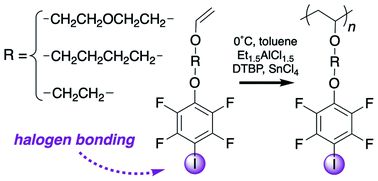Halogen bonding is rapidly becoming recognized as a viable and useful intermolecular interaction in supramolecular chemistry. While various monomers amenable to radical polymerization methods containing halogen bonding donors have been developed, this study aims to expand the type of monomers that incorporate this intermolecular interaction to facilitate use of cationic polymerization by developing three novel vinyl ether monomers containing halogen bonding donor moieties: 2,3,5,6-tetrafluoro-4-iodophenoxyethyl vinyl ether (C2I), 2,3,5,6-tetrafluoro-4-iodophenoxybutyl vinyl ether (C4I), and 2-(2,3,5,6-tetrafluoro-4-iodophenoxyethoxy)ethyl vinyl ether (O3I). Well controlled cationic polymerization is achievable through the use of a proton trap, 2,6-di-tert-butylpyridine. The use of SnCl4 as a co-Lewis acid was found to accelerate the reaction. Between the three monomers, the difference in the chain length is shown to influence the reaction rate, with the longest chain demonstrating the fastest polymerization. Initial studies of the halogen bonding ability shows that halogen bonding exists for all three monomers but is most pronounced in C4I. The polymerized vinyl ethers also exhibit halogen bonding. Due to the ease of synthesis and polymerization, these are promising new monomers to increase functionality available for polymers synthesized using cationic polymerization.

